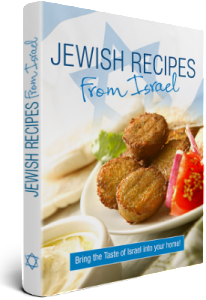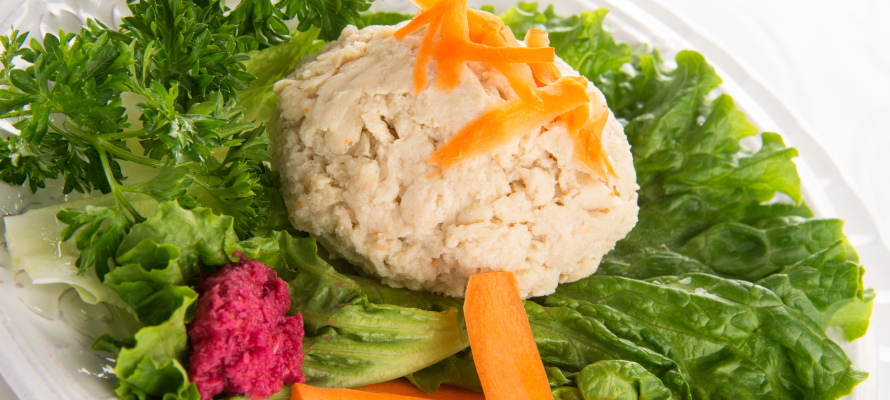
Rabbi Ari Enkin
Our series on Jewish cuisine turns to the tasty starters with which Ashkenazic Jews begin their meals.
In the first installment of this series, an Introduction to Jewish Cuisine and Traditional Shabbat Foods, we noted that Jewish cuisine is a collection of the different cooking traditions of the Jewish Diaspora worldwide. Jewish cuisine evolved over many centuries, and was shaped by Jewish dietary laws (kashrut), as well as Shabbat and holiday traditions, among other factors. In Part II of our series, we discuss popular Jewish appetizers – especially those served on Shabbat – along with traditional Shabbat bread.
Bread for the Sabbath and Holidays

Challah bread for sale in the market. (Photo: Shutterstock/evanstravels)
The challah bread is probably the most famous type of Jewish bread. It is often shaped into forms that have symbolic meanings. For example, a challah loaf is sometimes woven with six strands. Together, both loaves have twelve, which may represent each tribe of Israel. Other numbers of strands commonly used are three, five and seven. Occasionally twelve are used, referred to as a “Twelve Tribes” challah.
According to Jewish tradition, the three Sabbath meals (Friday night, Saturday lunch, and Saturday late afternoon) and the two holiday meals (one at night and lunch the following day) must all begin with two complete loaves of bread. This “double loaf” commemorates the manna that fell from the heavens when the Israelites wandered in the desert for 40 years after the Exodus from Egypt according to Jewish religious belief. The manna did not fall on Sabbath or holidays; instead, a double portion would fall the day before the holiday or Sabbath.
Chopped Liver
Chopped Liver is very popular in Ashkenazic circles. It is made by grinding sautéed or broiled liver and onions with a mixture of hard-boiled eggs, salt and pepper. The quintessential fat used is schmaltz, but different methods and ingredients exist, and the exact process and ingredients may vary from chef to chef. Shortening or oil is frequently substituted for schmaltz. It is often served with rye bread as sandwiches.
Chopped liver is high in protein but is also high in fat and cholesterol. Thus, low fat, mock, and vegetarian versions of chopped liver exist that are frequently made of a combination or base of peas, string beans, eggplant, or mushrooms.
Since chopped liver (or any dish made from internal organs, for that matter) is unappealing to many people, the expression “What am I, chopped liver?” signifies frustration or anger at being ignored on a social level.
Gefilte Fish
Gefilte fish, or “stuffed fish,” is an Ashkenazi Jewish dish made from a poached mixture of ground deboned fish, such as carp, whitefish or pike, which is typically eaten as an appetizer. Although the dish historically consisted of a minced-fish stuffed back inside the fish skin (as its name implies), the skin has commonly been omitted since the 19th century with the seasoned fish formed into patties similar to quenelles or fish balls. Gefilte fish is popular on Shabbat and holidays, especially Passover, although it may be consumed throughout the year.
While the Jewish Galitzianer community (from Galicia or modern-day Poland) prepares gefilte fish with sugar, the Litvak community (from Lithuania) seasons the dish with pepper. Referred to as the “Gefilte Fish Line,” this sugar-pepper boundary separates northern and southern Eastern European Jews. While traditionally made with carp, gefilte fish may also be made from any large fish, such as cod, haddock, pike, and whitefish.
Chrain: Red or White?
Chrain is a horseradish relish found in Ashkenazi Jewish cuisine. There are two common forms.

Download Jewish Recipes Today!
White chrain consists of grated horseradish, vinegar, sugar and salt, while red chrain includes the addition of beets. The use of chrain in Eastern European Jewish communities can be traced to writings from the 12th century. Though it has had several historical uses, chrain is most commonly associated in modern times with gefilte fish, for which it is considered an essential condiment. Chrain can be especially sharp or sweet, depending on the recipe.
By Rabbi Ari Enkin

Free Ebook: Jewish Recipes from Israel
Jewish food has developed over thousands of years, influenced by the diverse cultures and cooking from Jewish communities around the globe. As more and more Jews return to their Jewish homeland in Israel, new and exciting twists to traditional Jewish food come with them.
Get the best collection of Jewish recipes from Israel in this free exclusive Ebook from United with Israel.
Do You Love Israel? Make a Donation - Show Your Support!
Donate to vital charities that help protect Israeli citizens and inspire millions around the world to support Israel too!
Now more than ever, Israel needs your help to fight and win the war -- including on the battlefield of public opinion.
Antisemitism, anti-Israel bias and boycotts are out of control. Israel's enemies are inciting terror and violence against innocent Israelis and Jews around the world. Help us fight back!



